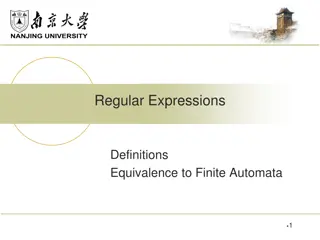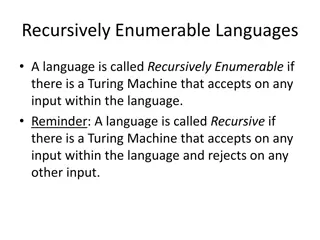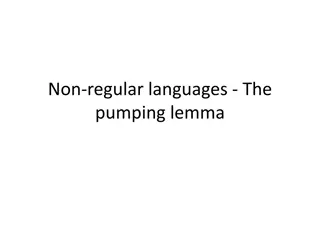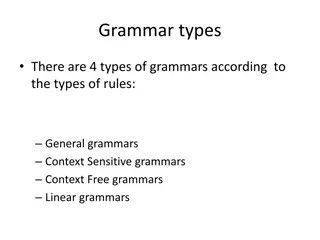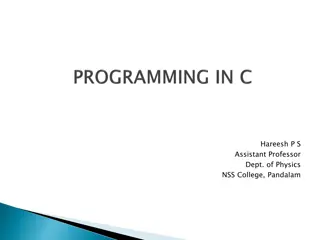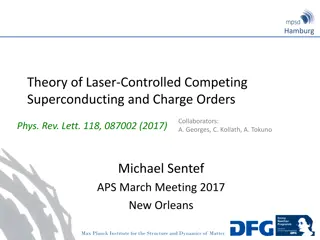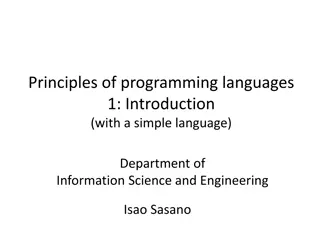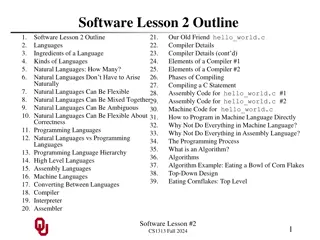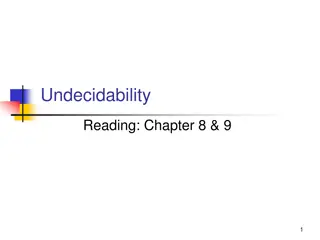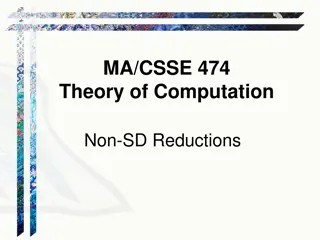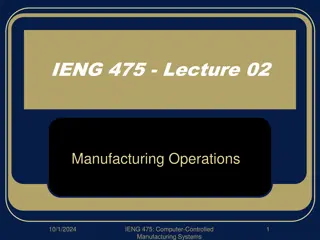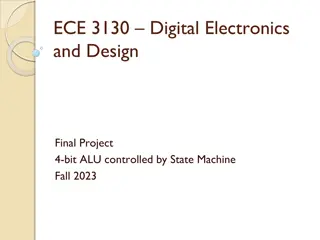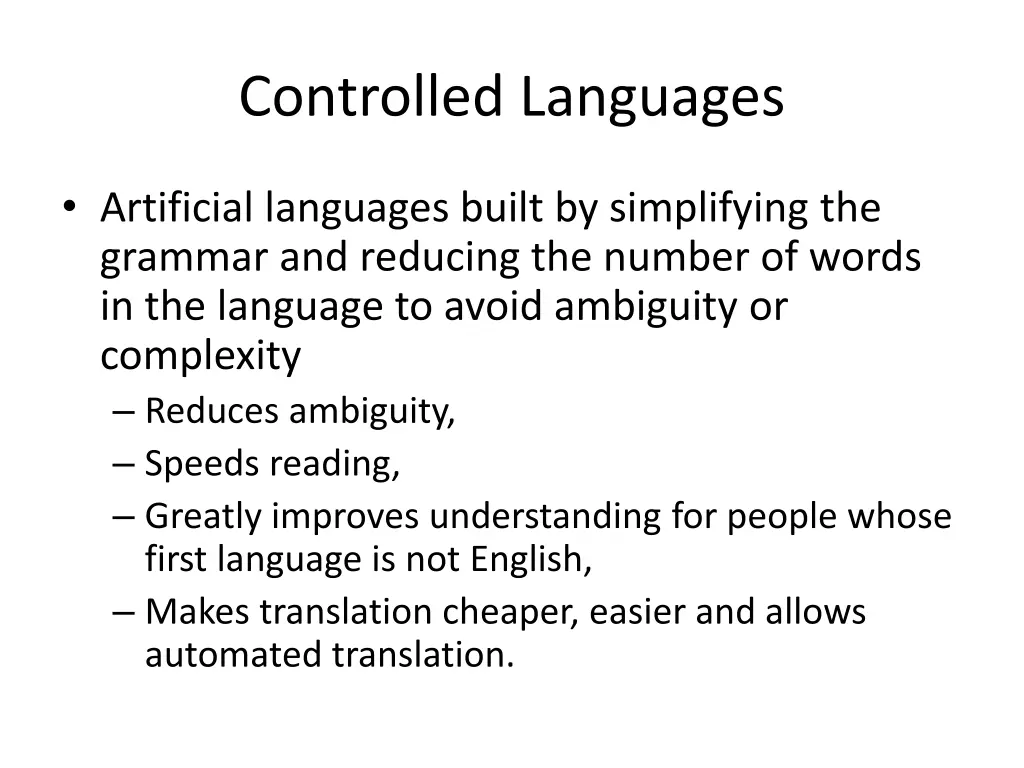
Benefits of Controlled Languages in Technical Communication
"Controlled Languages are artificial languages designed to simplify grammar and reduce ambiguity, aiding in better comprehension, faster reading, and easier translation. They find applications in technical documentation, reports, and help systems, improving communication efficiency."
Download Presentation

Please find below an Image/Link to download the presentation.
The content on the website is provided AS IS for your information and personal use only. It may not be sold, licensed, or shared on other websites without obtaining consent from the author. If you encounter any issues during the download, it is possible that the publisher has removed the file from their server.
You are allowed to download the files provided on this website for personal or commercial use, subject to the condition that they are used lawfully. All files are the property of their respective owners.
The content on the website is provided AS IS for your information and personal use only. It may not be sold, licensed, or shared on other websites without obtaining consent from the author.
E N D
Presentation Transcript
Controlled Languages Artificial languages built by simplifying the grammar and reducing the number of words in the language to avoid ambiguity or complexity Reduces ambiguity, Speeds reading, Greatly improves understanding for people whose first language is not English, Makes translation cheaper, easier and allows automated translation.
Uses of Controlled Languages Help systems. Technical specifications. Technical reports. Technical documentation.
How it works Lexicon of approved words, Each word can only be used as the part of speech as defined: "close" is a verb so: "Close the door" is correct, "do not go close to the landing gear" is wrong, "do not go near the landing gear" is acceptable. Words can only be used with the approved meaning: "follow" means to come after, so: "the puppy follows the adult, is correct, "follow the safety rules" is wrong, "obey the safety rules" is acceptable.
Simplify these Instructions 1. Authors will approach any writing project by collecting the necessary information first, and after carefully analyzing and evaluating it, they will create a structured draft. By optimizing their texts for easy comprehension, authors facilitate the translation process, and doing so enables machine translation systems to create better translation results. Consider these two sets of Instructions for installing the printer. After unpacking the printer from the shipping carton, take the printer out of the plastic bag. ... How to install your scanner. 1) Lift the scanner from the shipping box. 2) Discard all packaging material. Continue installing software? You, in your texts, to show that you can organize your thoughts, should use a simple sentence structure. A summary of questions will be sent to the responsible individuals. You must check the spelling of your text before publishing ti Test installation. Eschew obfuscation. 10. Texts that contein speling misstakes complicate the translation process. 2. 3. 4. 5. 6. 7. 8. 9.
CLOUT Rule 1 Controlled Language Rule 1: Write sentences that are shorter than 25 words. Write: The author performs the following tasks: Collect the necessary information. Analyze and evaluate the information. Write a structured draft. Do not write: Authors will approach any writing project by collecting the necessary information first, and after carefully analyzing and evaluating it, they will create a structured draft. CLOUT = Controlled Language Optimized for Uniform Translation developed by Uwe Muegge
CLOUT Rule 2 Controlled Language Rule 2: Write sentences that express only one idea. Write: Authors who optimize their texts for easy comprehension facilitate the translation process. These texts enable machine translation systems to produce better translation results. Do not write: By optimizing their texts for easy comprehension, authors facilitate the translation process, and doing so enables machine translation systems to create better translation results.
CLOUT Rule 3 Controlled Language Rule 3: Write the same sentence if you want to express the same content. Write: Printer Installation. 1) Remove the printer from the carton. 2) Remove the plastic wrapping. ... Scanner Installation. 1) Remove the scanner from the carton. 2) Remove the plastic wrapping. Do not write: Instructions for installing the printer. After unpacking the printer from the shipping carton, take the printer out of the plastic bag. ... How to install your scanner. 1) Lift the scanner from the shipping box. 2) Discard all packaging material.
CLOUT Rule 4 Controlled language rule 4: Write sentences that are grammatically complete. Write: Do you wish to continue the installation of the software? Do not write: Continue installing software?
CLOUT Rule 5 Controlled language rule 5: Write sentences that have a simple grammatical structure. Write: Show that you can organize your thoughts by using a simple sentence structure in your texts. Do not write: You, in your texts, to show that you can organize your thoughts, should use a simple sentence structure.
CLOUT Rule 6 Controlled language rule 6: Write sentences in the active form. Write: The program manager will send a summary of all questions to the responsible coworkers. Do not write: A summary of questions will be sent to the responsible individuals.
CLOUT Rule 7 Controlled language rule 7: Write sentences that repeat the noun instead of using a pronoun. Write: You must check the spelling of your text before you publish your text. Do not write: You must check the spelling of your text before publishing it.
CLOUT Rule 8 Controlled language rule 8: Write sentences that use articles to identify nouns. Write: Test the installation. Do not write: Test installation
CLOUT Rule 9 Controlled language rule 9: Write sentences that use words from a general dictionary. Write: Avoid ambiguity. Do not write: Eschew obfuscation.
CLOUT Rule 10 Controlled language rule 10: Write sentences that use only words with correct spelling. Write: Texts that contain spelling errors complicate the translation process. Do not write: Texts that contein speling misstakes complicate the translation procces.
Example Controlled Languages Avaya: Avaya Controlled English (ACE) Boeing: Simplified Technical English (STE), ASD-STE100. Caterpillar: Caterpillar Technical English (CTE), Caterpillar Fundamental English (CFE). Dassault Aerospace: Fran ais Rationalis . European Aeronautic Defence and Space Company (EADS): Simplified Technical English (STE), ASD-STE100. Ericsson: Ericsson English. General Motors (GM): Controlled Automotive Service Language (CASL). IBM: Easy English. Kodak: International Service Language. Nortel: Nortel Standard English (NSE). Oc : Controlled English. Rolls-Royce: Simplified Technical English (STE), ASD-STE100. Saab Systems: Simplified Technical English (STE), ASD-STE100. Scania: Scania Swedish. Sun Microsystems: Sun Controlled English. Xerox: Xerox Multilingual Customized English.
Fog Index Gunning fog index measures the readability of English text. Estimates the years of formal education needed to understand the text on a first reading. Fog Index Reading level by grade 17 College graduate 16 College senior 15 College junior 14 College sophomore 13 College freshman 12 High school senior 11 High school junior 10 High school sophomore 9 High school freshman General Target 8 Eighth grade 7 Seventh grade 6 Sixth grade http://gunning-fog-index.com/ http://www.jpgagefx.com/tools/read-able/
Guideline Guideline Use control language tools to create and check your text Always spell check and grammar check your text Discussion Question How does a control language differ from New Speak Newspeak is the fictional language in the novel Nineteen Eighty-Four, written by George Orwell. It is a controlled language created by a totalitarian state as a tool to limit freedom of thought, and concepts that pose a threat to the regime such as freedom, self- expression, individuality, and peace.

